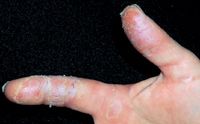- Case-Based Roundtable
- General Dermatology
- Eczema
- Chronic Hand Eczema
- Alopecia
- Aesthetics
- Vitiligo
- COVID-19
- Actinic Keratosis
- Precision Medicine and Biologics
- Rare Disease
- Wound Care
- Rosacea
- Psoriasis
- Psoriatic Arthritis
- Atopic Dermatitis
- Melasma
- NP and PA
- Skin Cancer
- Hidradenitis Suppurativa
- Drug Watch
- Pigmentary Disorders
- Acne
- Pediatric Dermatology
- Practice Management
- Prurigo Nodularis
- Buy-and-Bill
Article
Use of patch testing essential for faster, more effective tx
Allergic contact dermatitis can be a nightmare for those with serious cases, yet many dermatologists fail to use any form of patch test with their patients — a procedure that could lead to faster, more effective and definitive treatment, according to Bryan E. Anderson, M.D., assistant professor in the department of dermatology at Penn State University College of Medicine, Hershey, Pa.

"Allergic contact dermatitis is common in our practice, and the best way to diagnosis it is with patch testing," he told dermatologists at the 63rd Annual Meeting of the American Academy of Dermatology.

In both the T.R.U.E. and FINN Chamber patch tests, antigen concentrations are standardized to avoid false positives and false negatives - irritations being the most frequent cause of false positive reactions. A few essentials for both tests include a skin marking pen, a recording sheet, a refrigerator and educational handouts.
With a patch test clinic established, the question of who to patch test needs to be determined. Dr. Anderson suggests the criteria include at least one of the following: anyone with a chronic dermatitis, especially of the hands and feet; a highly suggestive history or distribution; dermatitis that does not respond to therapy; or occupationally related dermatitis.
According to Dr. Anderson, the proper approach to the contact dermatitis patient is to obtain a thorough history and skin examination; perform patch tests based on history, distribution of dermatitis, occupation and hobbies; review allergen exposure lists; and discuss appropriate prevention and therapy.
A case study of a 28-year-old hairdresser with a two-year history of hand eczema illustrates the value of patch testing. The woman revealed a history of childhood atopic dermatitis that improved on vacations. Treatments with topical and systemic steroids and moisturizers were helpful, but latex gloves were not. The question then became: is this atopic dermatitis, irritant or allergic dermatitis, tinea manuum, psoriasis or contact urticaria? To find out, Dr. Anderson first performed a bilateral hand, antecubital and popliteal fossa dermatitis exam. The KOH was negative, as was a use test to the latex gloves.
The patch tests included a standard tray of nickel, p-phenylenediamine (PPD), and rubber chemicals; a hairdresser tray including glyceryl thioglycolate and ammonium persulfate, as well as gloves. Patch test results proved positive to the PPD, which was relevant to hair color. Conclusively, the hairdresser stopped coloring hair and, while her hand dermatitis improved significantly, it did not totally clear. The final diagnosis? Allergic contact dermatitis to hair color and persistent atopic hand dermatitis.
Another case study illustrates the value of patch testing in a florist with frequent contact to two irritants: water and plants. Allergens used in the patch test included alstroemeria (tuliposide A) and chrysanthemum (sesquiterpene lactone). Results from using the standard tray were negative, but plant allergens including alstroemeria, tuliposide A and alpha-methylene-gamma-butyrolactone proved positive. The condition improved by avoiding alstroemeria. The diagnosis was allergic contact dermatitis and atopic dermatitis.






